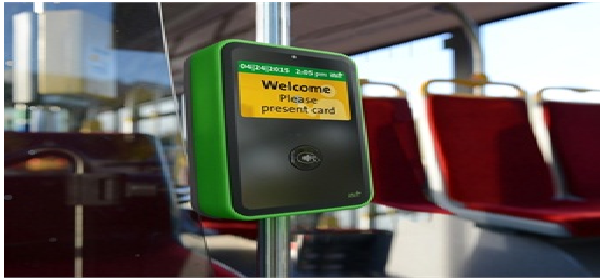Smart cards are used worldwide in transportation applications, with millions of smart cards in use for both transit fare payment and parking fee payment. For the purposes of fare payment in public transit, contactless smart cards are a clearly superior technology.
Smart Card enables bus operators to both issue contactless smart cards and cash paper tickets. Verification and reloading is conveniently done through mobile and desktop units. It also provides operators with an array of reporting tools, making use of computerized transaction records for extensive data review and analysis. It is also easy to manage system configurations, which equips operators with the flexibility to accommodate different business and fare structures, and operating environments.
Smart Cards System Architecture
- The solution comprises different subsystems, namely Reloading System, On-Board system, Depot Computer System, and Central Computer System.
- Reloading System is a subsystem in which cardholders pay to cashier in return for e-money.
- On-board system comprises Bus Validator, Driver Console and Ticket Printer, and Electronic Ticketing Machine (Optional). While the entire above are with payment functions, cardholder can also reload his/her card at Electronic Ticketing Machine.
- Depot Computer System gathers and uploads transaction records from On-Board System, meanwhile Central Computer System, where all the transaction records are stored, sends across data to On-Board System via Depot Computer System.
Benefits of contactless smart cards over magnetics in a modern transit agency environment
- Smart cards are more secure
- smart cards offer more storage and secure reading and writing of data thanks to a number of encryption algorithms and electronic keys. In transit, there are numerous examples of fraud with magnetic cards based on the poor security of the technology. Contactless smart card technology has been deployed at some of the largest transit agencies internationally.
- Contactless smart cards, which feature on-board microprocessors, are difficult to hack, replicate or counterfeit. By comparison, replicating a magnetic stripe card is easy and inexpensive. So, an investment in a contactless smart card system is also an investment in fraud prevention that will yield immediately measurable ROI.
- Smart cards are more reliable and reduce maintenance costs
- Those preoccupied with the expense of transitioning from magnetics should consider the long term. The maintenance savings alone of eliminating magnetic stripe tickets will more than offset the cost of switching to contactless smart cards.
- For one, smart cards are more reliable and durable with a failure rate of 1 in 25,000 transactions compared to 1 in 5,000 for magnetic stripe cards, according to IBM. Secondly, contactless validators have no mechanical parts, thereby reducing maintenance costs for both parts and labor. Finally, contactless smart cards are sturdy and waterproof, requiring fewer replacements than magnetic stripe cards that are easily damaged by magnetic fields, moisture or normal wear and tear.
- Smart cards are faster and easier to use
- Smart cards can perform complicated transactions in very little time, automatically allocating charges for each stage or mode of travel. In conjunction with the ability to recharge via web or mobile, this improves passenger experience and provides ease of use.
- As to speed: A typical contactless smart card transaction takes about 300 milliseconds – there’s no need to fumble through a wallet or purse, feed tickets into machines, or navigate a turnstile. Improving experience and getting more passengers boarded, faster, means increased operational efficiencies, greater on-time bus performance and lower total cost of provisioning the service.
- Smart cards lower operating costs and reduce losses from fare evasion
- Yes, deploying a contactless smart card system is an investment, but it’s a good investment. As noted above, reduced expense in maintenance costs more than make up for the upfront expense. And, although producing magnetic stripe cards is less expensive, contactless smart cards are still less costly overall because of the lower equipment costs and usable life of the smart card.
- Smart cards have great BI benefits
- By creating a repository for contactless smart card data and linking it to other databases and systems across the transit enterprise, the agency creates a powerful business intelligence engine for route planning, in particular.
- This is the direction the industry is going – connecting data from smart payments systems and all across the enterprise to improve every facet of experience and operational performance.

